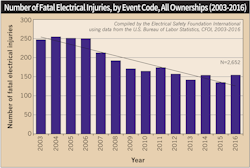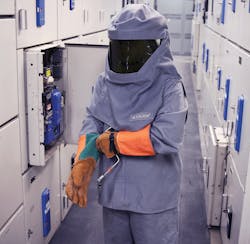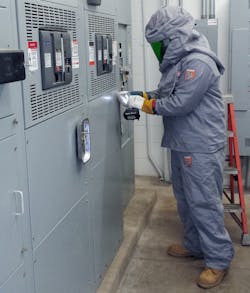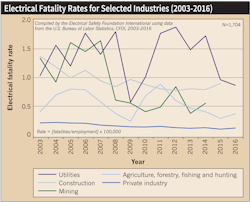On assignment at a South Carolina plastic bottle plant, an outside contractor’s electrical supervisor with 27 years of experience troubleshoots a control panel for a just-installed compressor motor; the starter indicator light comes on, but the motor isn’t engaging. As an assistant retrieves a multimeter so he can check the continuity of the wiring, the supervisor opens the starter control panel door, reaches in, and begins tracing the wiring to check the integrity of the leads. He contacts the 480V primary lead with his left hand and is electrocuted, dying at a hospital 90 minutes later.
At a Kentucky woodworking company, the factory manager is summoned to the production floor when a saw stops working. He goes to a control panel, extends an arm to reset a relay, and makes contact with 480V. After slumping to the floor, an employee performs CPR while 9-1-1 is called. Rushed to a hospital, he later dies of cardiac arrest.
Twenty-two years — and steady advancements in understanding and addressing workplace electrical safety — separated the first incident from the second, yet little was different. Those who should have known better failed to de-energize equipment, and paid with their lives.
“Both of these scenarios would have been prevented by properly following lockout/tagout procedures, but the lockout/tagout regulations were just starting to be enforced by OSHA in the 1990s,” says John Robinson, the lead LOTO specialist with Milwaukee-based Brady Corp., a provider of workplace electrical safety products and services. “Unfortunately, 30 years later this is still one of the top cited violations by OSHA, and people are dying as a result of these procedures not being utilized.”
An official report on the 1992 bottling plant accident, filed for the National Institute for Occupational Safety and Health’s (NIOSH) Fatality Assessment and Control (FACE) program, concluded the supervisor should have known it was unnecessary — and dangerous — to leave circuits energized while tracing and checking electrical leads. The mishap occurred despite the contractor having a written safety program and monthly safety meetings.
Likewise, the FACE report on the 2014 woodworking company incident determined the victim died because he didn’t follow written company procedures on de-energizing equipment. Just nine months earlier, company employees had received LOTO/verification training.
In both cases, and in many similar ones NIOSH has documented, victims were performing routine operations and maintenance tasks on factory floors/construction sites and got caught up in a cascade of events: eagerness to quickly complete a task; lack of awareness, understanding, or appreciation of risk; and failure to follow prescribed safe procedures. NIOSH incident reports often reference other causal factors like poor communication, inappropriate personal protective gear, exposed voltage, and damaged equipment, but simple human error is a common thread in many electrical accidents.
Now What?
What more can be done to reduce workplace injuries and fatalities from contact with energized electrical equipment, encounters that are highly preventable because they can often be anticipated? It’s a pressing question because such accidents remain all too common. In 2016, 154 workers died from electric shock or burns, a 15% increase from 2015, according to Electrical Safety Foundation International (ESFI). Yet fatal electrical injuries have come down since 2003 (Fig. 1). And, though down a third, non-fatal electrical injuries resulting in lost work time still totaled 1,640 in 2016; more than four occur each day. And construction workers clearly suffer the most (Fig. 2).
The short answer is more of the same — and maybe even more of something newer — to reduce human error, continue beating the drum on the need to approach any interaction with energized electrical equipment with extreme caution, but also to work harder to institute rules, minimize hazards, and reduce risk. The latter tactic has been gaining steam in operations and maintenance (O&M) circles, where the mission includes maximizing productivity by refining processes, procedures, and infrastructure.
To increase the margin of safety, plant safety managers are trying new approaches, among them establishing clearer protocols for safe work, better cataloguing and quantifying dangers, and hardening electrical distribution systems to make them safer. The surest path to fewer accidents is obvious, but bears repeating, electrical safety experts say, because it’s not always followed: Before commencing almost any work, de-energize. That’s gospel in NFPA 70E, Standard for Electrical Safety in the Workplace, but unless it’s done religiously — and properly — it offers no assurance to workers.
Experts say workplaces serious about reducing electrical accidents should craft and enforce rules on de-energizing, and make sure energized work permits are completed, and only “qualified” electrical workers are deployed with the right personal protective equipment (PPE) when that’s not possible. To ensure it’s done properly, employers must invest time in developing detailed and tailored LOTO/verification procedures.
“That can be very complex and time-consuming because a process is really needed for each piece of equipment,” Robinson says. “Safety teams need to work closely with O&M people to develop them and follow up with training.”
NIOSH documented an electrocution illustrating the importance of the de-energization protocol. Completing work on a machine that had its 440V motor replaced the night before, a textile plant maintenance worker signaled to have the machine re-started. Simultaneously, his hand was touching an exposed conductor on the junction box that supplied power to the motor. When it started, he was electrocuted. NIOSH blamed the accident on a lack of LOTO procedures, failure to replace the junction box cover following de-energization the night before, and a worker’s failure to verify the victim was clear of danger before machine re-start.
That happened in 1988. Since then, understanding of LOTO’s nuances has grown. But the incident shows that unless LOTO procedures are in place — and strictly followed — even the simplest electrical equipment work performed by O&M teams can spell disaster.
“There’s still the challenge of breaking bad habits and understanding it’s not just hazardous tasks that pose dangers, but routine ones where people let their guard down and overlook hazards,” says Tommy Northcott, P.E., a senior power engineer who specializes in workplace electrical safety for Jacobs, a Tullahoma, Tenn., engineering consultancy.
Arc Flash Progress
Creating a safer electrical work environment also calls for building greater awareness of arc flash/arc blast hazards. A danger that has become better understood and more manageable over time, arcing leads to far fewer deaths than electrocution, but poses a serious threat to workers. In fact, it may injure more workers than shock. Step one in avoiding it during equipment maintenance and repair is assessing the risk of its occurrence and relative danger. The best way to do that is to conduct detailed arc flash studies, experts say.
Josh Mikels, P.E., the lead arc flash specialist at Brady, says an analysis of each piece of electrical equipment can produce readings on the amount of incident energy that could be encountered by workers. While calculations are available through a speedier “table method” of calculation in NFPA 70E, a formal study provides more certainty and can reveal better mitigation tactics and safe boundaries for workers.
“When you do an assessment, you’re telling someone whether you’re potentially dealing with a firecracker or a nuclear weapon,” he says.
That’s important to know, because it informs how work is performed on equipment and the type of PPE that must be worn to withstand an arc flash or blast should one occur. Too many companies, Mikels says, risk sending workers into potential arcing situations with PPE that doesn’t protect, raising the risk of severe injury. “If you’re doing that work with the wrong PPE, you’re in danger. It’s like trying to cross an eight-lane expressway in LA.”
That appropriate-PPE gap probably aligns with the number of companies that have yet to conduct or outsource comprehensive arc flash studies.
“More companies have probably developed lockout/tagout procedures than have done arc flash studies,” says Mikels. “My guess is less than half of all facilities have one in place.”
Another safety deficiency that likely exists in many facilities but is hard to quantify, experts say, is potentially degraded PPE. Over time, materials in PPE, like rubber, can lose their protective qualities. Companies taking the lead on worker safety should have programs in place to ensure PPE is up to the task, says Todd Truettner, group safety manager at ABM Industries, a New York-based facility management services company.
“We see a lot of supposedly arc-rated gloves in use that are out-of-date,” he says. “But busy facilities running 10 hours a day don’t have time to think about that and remember to periodically replace them.”
ABM, he says, has partnered with a company that offers a glove rotation program to ensure they’re replaced on a regular schedule, usually every six months. That eliminates the need for facilities to handle the task of either regular replacement or inspection and replacement.
Properly maintaining PPE has grown in importance because it’s become central to electrical safety. Advances in materials and design have improved its performance and made it more comfortable. That’s increased the likelihood that workers will use it, but Truettner says many still need a nudge to regularly suit up. For its part, ABM is providing that by issuing workers it deploys to client sites Level 2 backpacks that contain both tools and PPE. “It’s easy to carry up and down ladders,” he says, “so there’s no reason for them to say they didn’t have the gear.”
Maintaining for Safety
Last-line defenses against electrical accidents, such as PPE, and ones a bit higher up the chain, like LOTO, are critical to safety. But higher-level ones that make the work environment electrically safer are perhaps drawing more attention.
One key area is electrical equipment maintenance, a pursuit that’s essential to ensuring proper and dependable operation and productivity. But it’s also vital to keeping electrical systems and their built-in safety features working as designed.
Frequency and thoroughness are two key variables in maintaining system electrical components with an eye to safety, but they’re two areas that can challenge facility O&M departments. Maintenance can be costly and time-consuming, and require equipment to be taken off line. Doing so unexpectedly, when problems arise, can be disruptive.
While regularly scheduled preventive maintenance is one solution, another that’s drawing more attention is predictive maintenance done with the help of condition monitoring tools that can flag potential problems. Either way, maintenance done on some sort of regular basis is the key to keeping electrical components running properly, and properly implies safely. It’s so critical to worker safety that it’s detailed in NFPA 70B, Recommended Practice for Electrical Equipment Maintenance.
“Postponed maintenance can be a problem,” says Truettner. “It’s very common for circuit breaker blades to become stuck, for instance, and that can be an issue when equipment has to be brought down. If equipment is maintained properly, that can be avoided.”
Routinely exercising switches and circuit breakers is an essential part of regular maintenance, says Mikels. “If a breaker doesn’t move for 10 years or more, what can happen is that when it needs to trip it might not function properly, and a
fraction of second in delay can make a world of difference. Tripping in 0.03 seconds could cause a small arc flash, but if it takes 0.33 seconds, a first-degree burn can quickly become third-degree.”
Higher-tech approaches are also becoming more important to ensuring workers are protected from unsafe electrical equipment. Regular infrared (IR) thermography, done annually for the best value, Mikels says, can catch problems before they become full-flown safety issues.
“IR can identify hot spots from things like loose connections on conductor lugs potentially caused by motor vibrations, or metal changing size and shape from dissimilar metals heating up and cooling down,” he says. “When you have corrosion or loose connections, that creates resistance and heat, which then leads to a higher potential for arcing and accidents.”
Periodic comprehensive maintenance that involves de-energization is a must, but paying close attention to day-to-day operation can pay safety dividends. It’s important, Mikels adds, for electrical equipment cabinets to remain free of moisture, a common problem found in food plants that can spawn electrical issues, and also free from potentially combustible dust that can build up in manufacturing processes.
Indeed, prevention is one important leg of the electrical safety stool, and progress in making workplaces inherently safer has helped keep fatal electrical accidents mostly at bay, while non-fatal injuries seem to be declining. Though fatalities spiked in 2016, ESFI isn’t sounding any alarm bells that the long-term trend is up. ESFI says one of every 34 workplace fatalities had an electrical cause in 2016 compared to one in 23 in 2003. Construction settings, different in many ways from fixed workplaces, remain the problem area, accounting for 53% of electrical fatalities in 2016 (see Fig. 3).
Still, of course, one fatality or injury is too many, and workplaces still have much work to do to make either outcome more unlikely. The kinds of accidents that happened 30 years ago still happen, and workers remain at risk. But on many fronts — from strict work rules and better protective gear to improved equipment maintenance and greater understanding of hazards — the foundation for improvement is in place.
Zind is a freelance writer based in Lees Summit, Mo. He can be reached at [email protected].
SIDEBAR: A Triage Approach to Preventing Electrical Accidents
“Build for safety.” That could be the rallying cry for the next generation of workplace electrical safety gurus.
A “prevention through design” concept is taking root, inspiring a push to put workplace electrical fatalities on a downward slope. It elevates the idea that designing or modifying electrical infrastructure to be safer could
reduce the outsized impact that human error has on fatal accidents. The approach is a foundation of a broader template for safety, the hierarchy of controls. It prioritizes elimination or reduction of hazards in the environment over other measures that are too dependent on unreliable human performance.
“A flattening in the incidence of electrical fatalities in recent years suggests we need to do something differently with hazards that have high potential for fatal encounters,” says Lanny Floyd, an electrical systems safety expert who spent 45 years at DuPont before joining the Advanced Safety Engineering and Management faculty at the University of Alabama at Birmingham.
The hierarchy, endorsed by OSHA and first referenced in the 2015 edition of NFPA 70E, Standard for Electrical Safety in the Workplace, says that before anything, try to eliminate hazards. That could be something as simple as reducing the number of luminaires, Floyd says, which would translate to a permanent reduction in worker exposure to energized circuits. Substitution is the next best approach, an example being replacement of 120V machine controls with 24V controls, he says.
Further down the hierarchy are measures that are action-dependent or provide uncertain buffers to mistakes or unforeseen events. They include: engineering controls, such as ground fault circuit interrupters (GFCIs) and touch-safe terminal blocks; warnings, such as signs, lights, and barricades; administrative controls ranging from safe work practices training and lockout/tagout (LOTO)procedures to audits and personnel selection; and personal protective equipment (PPE) that requires workers to suit up. They’re all proven approaches to increasing the margin of safety, Floyd says, but they lack an assurance of safety.
“We need a focus on working safely, training, assuring competency, and better PPE, but they have weaknesses because they all require someone to do the right thing at the right time, every time,” Floyd says.
Design has produced innovations that have advanced electrical safety, including enclosures that came to the fore in the 1930s, GFCIs in the 1960s, and arc fault circuit interrupters (AFCIs) in the last decade, Floyd says. More innovative thinking along those lines, he says, coupled with continued efforts to eliminate human error, could make potentially fatal interactions with electrical current an extremely rare occurrence.
About the Author
Tom Zind
Freelance Writer
Zind is a freelance writer based in Lee’s Summit, Mo. He can be reached at [email protected].






